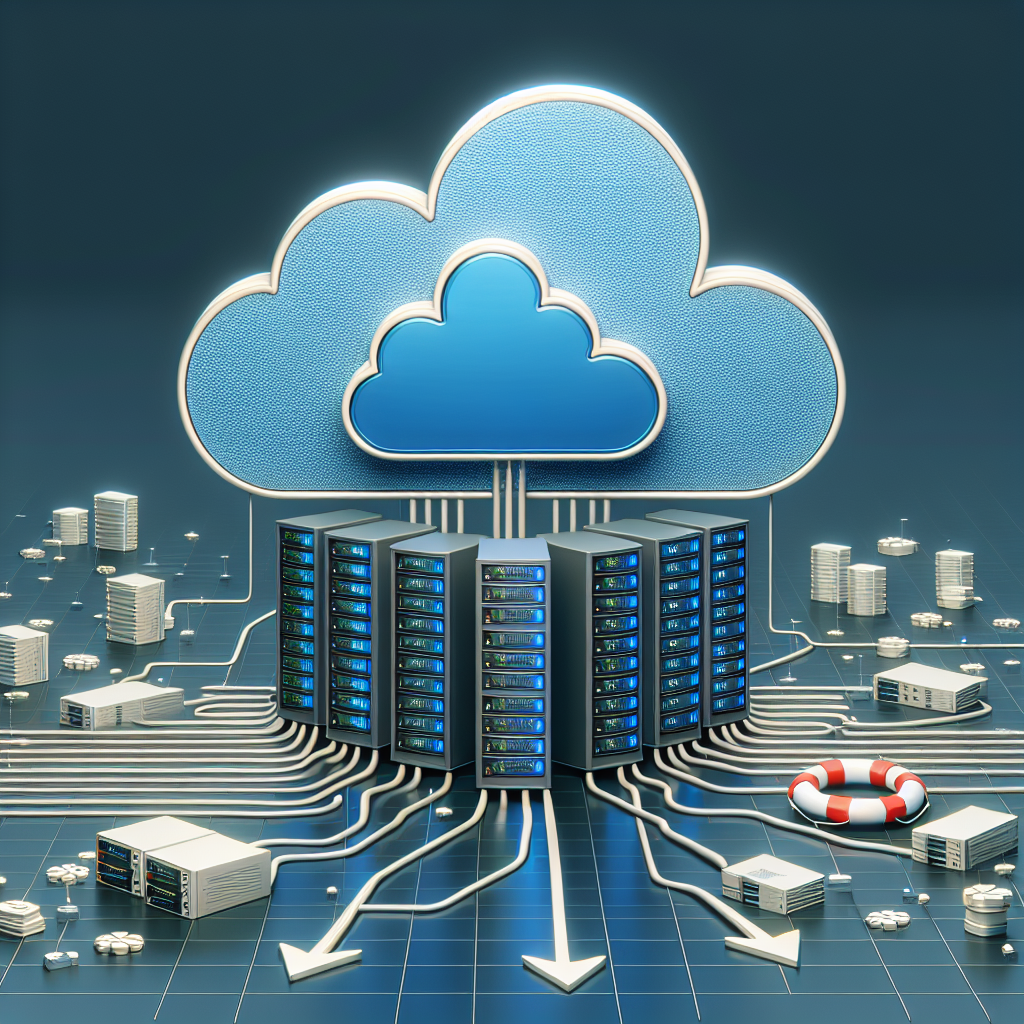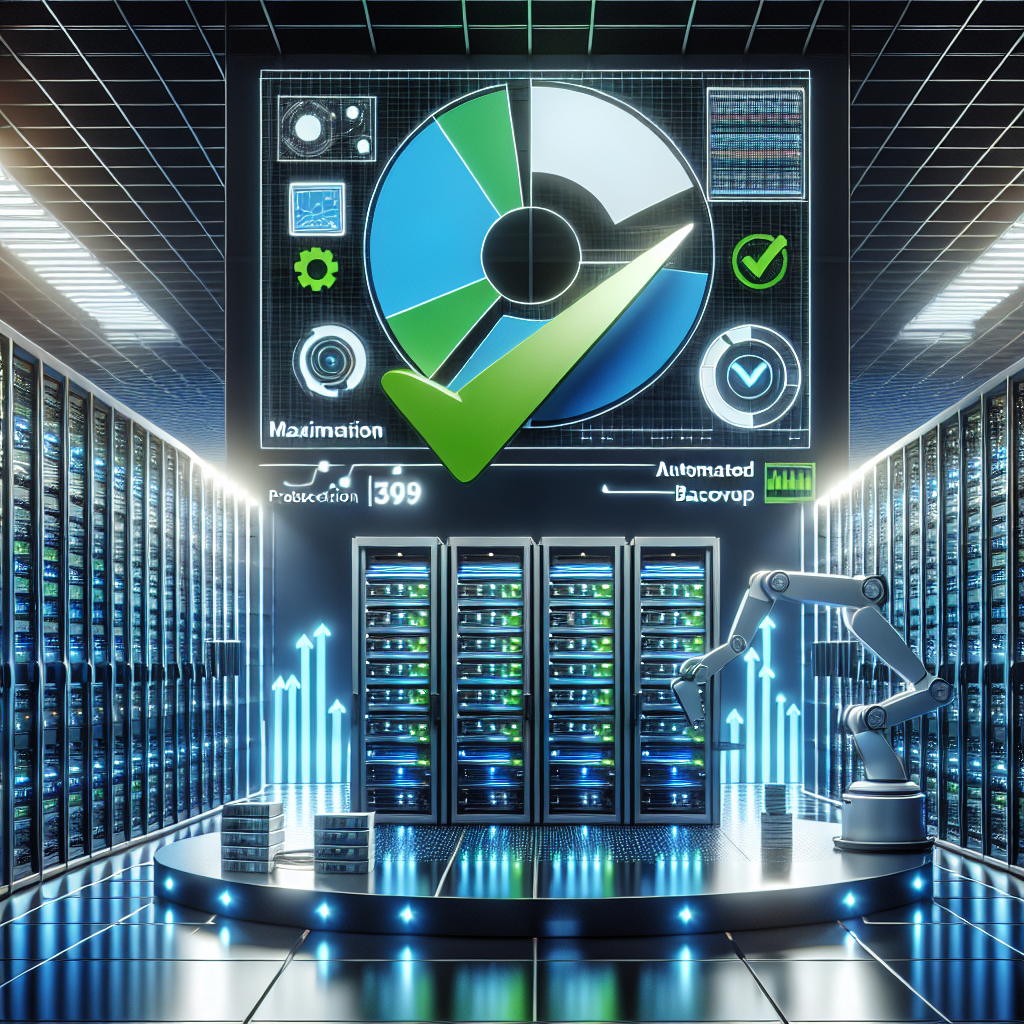Your cart is currently empty!
Tag: Backup

Data Center Backup and Recovery: A Comprehensive Guide for IT Professionals
Data centers play a crucial role in the smooth functioning of any organization’s IT infrastructure. They store and process vast amounts of critical data, making them a prime target for cyber attacks, natural disasters, and other unforeseen events that can jeopardize the integrity of this data. This is why having a robust backup and recovery plan in place is essential for IT professionals responsible for managing data centers.Data center backup and recovery involves creating and maintaining copies of data in case of data loss or corruption, and restoring this data to its original state in the event of a disaster. It is a critical component of any organization’s IT strategy, as it ensures business continuity and minimizes downtime in the face of unexpected events.
There are several key considerations that IT professionals need to take into account when designing a data center backup and recovery plan. These include:
1. Understanding the data: Before implementing a backup and recovery plan, it is essential to understand the types of data that need to be backed up, their criticality, and how often they need to be backed up. Not all data is created equal, and prioritizing critical data can help streamline the backup and recovery process.
2. Choosing the right backup solution: There are several backup solutions available in the market, including tape backups, disk-to-disk backups, cloud backups, and hybrid backups. IT professionals need to evaluate their organization’s needs and budget to choose the right solution that meets their requirements.
3. Implementing a backup schedule: Establishing a regular backup schedule is crucial to ensure that data is backed up consistently and in a timely manner. This schedule should take into account the frequency of data changes and the organization’s recovery time objectives (RTO) and recovery point objectives (RPO).
4. Testing the backup and recovery plan: It is essential to regularly test the backup and recovery plan to ensure that data can be restored successfully in the event of a disaster. Testing helps identify any gaps or weaknesses in the plan and allows IT professionals to make necessary adjustments.
5. Monitoring and managing backups: Monitoring the backup process is crucial to ensure that backups are completed successfully and that any issues are promptly addressed. IT professionals should also regularly review and update the backup plan to accommodate changes in the organization’s IT infrastructure.
In conclusion, data center backup and recovery is a critical aspect of IT management that ensures the continuity of business operations in the face of unforeseen events. By understanding the data, choosing the right backup solution, implementing a backup schedule, testing the plan, and monitoring backups, IT professionals can create a comprehensive backup and recovery strategy that safeguards their organization’s data and ensures business continuity.

The Evolution of Data Center Backup and Recovery Technologies
Data center backup and recovery technologies have come a long way since the early days of computing. As data has become increasingly critical to businesses, the need for reliable backup and recovery solutions has grown exponentially. In this article, we will explore the evolution of data center backup and recovery technologies and how they have evolved to meet the changing needs of businesses.In the early days of computing, data center backup and recovery were often manual processes that involved copying data to tapes or other physical media. This was a time-consuming and error-prone process that left businesses vulnerable to data loss in the event of a disaster. As technology advanced, so too did data center backup and recovery solutions.
One of the major advancements in data center backup and recovery technologies was the development of disk-based backup solutions. These solutions allowed for faster backup and recovery times, as well as more reliable data protection. Disk-based backup solutions also allowed for more frequent backups, reducing the risk of data loss in the event of a disaster.
Another key development in data center backup and recovery technologies was the introduction of cloud backup solutions. Cloud backup solutions allow businesses to store their data offsite, providing an added layer of protection in the event of a disaster. Cloud backup solutions also offer scalability and flexibility, allowing businesses to easily expand their backup and recovery capabilities as needed.
In recent years, data center backup and recovery technologies have continued to evolve with the introduction of technologies such as deduplication and snapshotting. Deduplication technology allows businesses to reduce the amount of data that needs to be backed up, saving both time and storage space. Snapshotting technology allows businesses to take point-in-time snapshots of their data, providing a fast and efficient way to recover data in the event of a disaster.
Overall, the evolution of data center backup and recovery technologies has been driven by the increasing importance of data to businesses and the need for reliable and efficient backup and recovery solutions. Businesses can now choose from a wide range of backup and recovery technologies to meet their specific needs, from traditional tape backups to cutting-edge cloud solutions. As technology continues to advance, we can expect to see even more innovations in data center backup and recovery technologies in the years to come.

Data Center Backup and Recovery: Tips for Ensuring Data Integrity and Security
Data centers are the heart of any organization’s IT infrastructure, housing critical data and applications that are essential for the day-to-day operations of the business. With the increasing amount of data being generated and stored, it is more important than ever to have a robust backup and recovery plan in place to ensure data integrity and security.Data center backup and recovery involves the process of making copies of data and storing them in a secure location to prevent loss in the event of a disaster or data corruption. It is crucial for organizations to regularly backup their data to protect against potential threats such as hardware failure, cyber attacks, natural disasters, or human error.
Here are some tips for ensuring data integrity and security in data center backup and recovery:
1. Regularly schedule backups: It is essential to establish a regular backup schedule to ensure that all critical data is backed up frequently. Depending on the organization’s needs, backups can be scheduled daily, weekly, or monthly.
2. Implement a multi-tiered backup strategy: A multi-tiered backup strategy involves storing data in multiple locations and formats to provide redundancy and increased security. This can include using a combination of on-site and off-site backups, as well as cloud storage solutions.
3. Encrypt backup data: Encrypting backup data ensures that it remains secure and protected from unauthorized access. Encryption should be applied to both data in transit and at rest to prevent data breaches and ensure compliance with data protection regulations.
4. Test backups regularly: It is important to regularly test backups to ensure that data can be successfully restored in the event of a disaster. This helps identify any potential issues or gaps in the backup process and allows for adjustments to be made as needed.
5. Monitor backup processes: Monitoring backup processes allows organizations to proactively identify and address any issues that may arise, such as failed backups or storage capacity limitations. This ensures that data is consistently backed up and protected.
6. Maintain an up-to-date inventory of data: Keeping an up-to-date inventory of data helps organizations identify critical data that needs to be backed up and prioritized. This also helps in determining data retention policies and ensuring compliance with data privacy regulations.
In conclusion, data center backup and recovery are essential components of a comprehensive data protection strategy. By following these tips and best practices, organizations can ensure data integrity and security, minimize the risk of data loss, and maintain business continuity in the face of potential threats. Remember, it’s not a matter of if a disaster will strike, but when – so being prepared with a solid backup and recovery plan is crucial for the long-term success of any organization.

The Role of Cloud Backup in Data Center Recovery Plans
Data center recovery plans are essential for businesses to ensure that their data and operations can be quickly restored in the event of a disaster or system failure. One crucial component of a data center recovery plan is cloud backup.Cloud backup involves storing data and applications on remote servers accessed through the internet. This allows businesses to quickly recover their data in the event of a disaster, such as a ransomware attack, natural disaster, or hardware failure.
One of the key benefits of using cloud backup in data center recovery plans is that it provides an offsite storage solution for critical data. This ensures that even if the primary data center is compromised, the data can still be accessed and restored from the cloud. This redundancy helps to minimize downtime and ensure business continuity.
Another advantage of cloud backup is its scalability and flexibility. Businesses can easily increase or decrease their storage capacity as needed, without the need for physical hardware upgrades. This allows for a cost-effective solution that can grow with the business.
Cloud backup also offers enhanced security features, such as encryption and multi-factor authentication, to protect data from unauthorized access. This helps to ensure that sensitive information remains secure, even in the event of a breach.
Additionally, cloud backup provides automated backups and recovery processes, reducing the need for manual intervention and minimizing the risk of human error. This ensures that data is consistently backed up and can be quickly restored when needed.
In conclusion, cloud backup plays a crucial role in data center recovery plans by providing offsite storage, scalability, security, and automation. Businesses that incorporate cloud backup into their recovery plans can mitigate the risk of data loss and downtime, ensuring that they can quickly recover and resume operations in the event of a disaster.

Maximizing Data Protection with Automated Backup and Recovery in the Data Center
In today’s digital age, data protection is more important than ever. With cyber threats on the rise and data breaches becoming increasingly common, businesses must take proactive measures to safeguard their sensitive information. One of the most effective ways to do this is through automated backup and recovery in the data center.Automated backup and recovery solutions are essential for ensuring that critical data is protected and easily recoverable in the event of a disaster. By automating the backup process, businesses can ensure that their data is regularly backed up without the need for manual intervention. This not only saves time and resources, but also reduces the risk of human error that can lead to data loss.
In addition to regular backups, automated recovery solutions play a crucial role in maximizing data protection. In the event of a system failure or cyber attack, automated recovery tools can quickly and efficiently restore data to its original state, minimizing downtime and ensuring business continuity. This is essential for preventing costly disruptions and maintaining customer trust.
Furthermore, automated backup and recovery solutions offer advanced features such as data encryption, compression, and deduplication, which further enhance data protection. Encryption ensures that data is securely stored and transmitted, while compression and deduplication reduce storage requirements and improve efficiency.
By implementing automated backup and recovery solutions in the data center, businesses can maximize their data protection efforts and minimize the risk of data loss. These solutions help businesses comply with industry regulations, protect sensitive information, and maintain a competitive edge in today’s data-driven economy.
In conclusion, automated backup and recovery solutions are essential for maximizing data protection in the data center. By automating the backup process, businesses can ensure that their data is regularly backed up and easily recoverable in the event of a disaster. These solutions offer advanced features such as encryption, compression, and deduplication, which further enhance data protection. Overall, investing in automated backup and recovery solutions is a smart decision for businesses looking to safeguard their critical data and maintain business continuity in today’s digital age.

The Role of Backup Power in Data Center Resilience
In today’s digital age, data centers play a critical role in the functioning of businesses and organizations. These facilities house servers, networking equipment, and storage systems that are essential for storing and processing data. However, data centers are not immune to disruptions such as power outages, which can have a significant impact on their operations. This is where backup power systems come into play.The role of backup power in data center resilience cannot be overstated. In the event of a power outage, backup power systems ensure that critical infrastructure remains up and running, minimizing downtime and preventing data loss. There are several types of backup power systems commonly used in data centers, including uninterruptible power supplies (UPS), generators, and fuel cells.
UPS systems are essential for providing immediate power backup in the event of a power outage. These systems are designed to provide a seamless transition to battery power when the main power source fails, ensuring that critical equipment remains operational until a generator or alternative power source can be activated. UPS systems also help regulate power fluctuations and protect equipment from surges and spikes.
Generators are another key component of backup power systems in data centers. These devices are capable of providing long-term power backup during extended outages, ensuring that data center operations can continue uninterrupted. Generators are typically powered by diesel fuel or natural gas and are capable of supplying power for extended periods of time.
Fuel cells are a newer technology that is gaining popularity in data centers as a backup power source. These devices generate electricity through a chemical reaction between hydrogen and oxygen, producing clean and reliable power. Fuel cells are highly efficient and environmentally friendly, making them a sustainable option for backup power in data centers.
In addition to providing immediate power backup during outages, backup power systems also play a crucial role in maintaining data center resilience. By ensuring that critical infrastructure remains operational, backup power systems help prevent data loss, system downtime, and potential financial losses for businesses and organizations.
In conclusion, the role of backup power in data center resilience is essential for ensuring the continuous operation of critical infrastructure and minimizing the impact of power outages. By investing in reliable backup power systems such as UPS, generators, and fuel cells, data centers can enhance their resilience and ensure that they can continue to support the needs of businesses and organizations in an increasingly digital world.

Choosing the Right Backup and Recovery Solutions for Your Data Center
Data is the lifeblood of any organization, and ensuring its safety and availability is crucial for the smooth operation of a business. With the increasing amount of data being generated and stored by companies, having a reliable backup and recovery solution in place is more important than ever.When it comes to choosing the right backup and recovery solutions for your data center, there are several factors to consider. Here are some tips to help you make the best decision for your organization.
1. Assess your data needs: Before you start looking for backup and recovery solutions, it’s important to assess your data needs. Consider the amount of data you have, how frequently it is generated and updated, and how quickly you need to recover it in case of a disaster. Understanding your data requirements will help you choose a solution that meets your specific needs.
2. Consider your budget: Backup and recovery solutions come in a wide range of prices, so it’s important to consider your budget before making a decision. While it may be tempting to opt for the cheapest option, keep in mind that investing in a reliable backup and recovery solution is a wise investment that can save you money in the long run by preventing data loss and downtime.
3. Evaluate different solutions: There are several backup and recovery solutions available on the market, ranging from traditional tape backups to cloud-based solutions. Take the time to evaluate the pros and cons of each option to determine which one is best suited for your organization. Consider factors such as scalability, ease of use, and security features when making your decision.
4. Consider disaster recovery capabilities: In addition to backing up your data, it’s important to consider the disaster recovery capabilities of your chosen solution. Make sure that the solution you choose offers fast and reliable recovery options in case of a disaster, such as natural disasters, cyberattacks, or hardware failures.
5. Test your backup and recovery plan: Once you have chosen a backup and recovery solution, it’s important to regularly test your backup and recovery plan to ensure that it works as intended. Conducting regular tests will help you identify any weaknesses in your plan and make necessary adjustments to improve its effectiveness.
In conclusion, choosing the right backup and recovery solution for your data center is a critical decision that can have a significant impact on the success of your organization. By assessing your data needs, considering your budget, evaluating different solutions, considering disaster recovery capabilities, and testing your backup and recovery plan, you can ensure that your data is safe and secure in case of a disaster.

Best Practices for Data Center Backup and Recovery Strategies
In today’s digital age, data is the lifeblood of businesses. From customer information to financial records, data plays a critical role in decision-making and operations. Therefore, it is essential for organizations to have a robust backup and recovery strategy in place to protect their valuable information.Data center backup and recovery strategies are designed to ensure that data is securely backed up and can be quickly restored in the event of a disaster or data loss. However, not all backup and recovery strategies are created equal. To ensure that your organization’s data is protected, it is important to follow best practices for data center backup and recovery strategies.
1. Regularly back up your data: One of the most important best practices for data center backup and recovery strategies is to regularly back up your data. This includes not only critical business data but also applications and system configurations. By scheduling regular backups, you can ensure that your data is always up-to-date and can be quickly restored in the event of a failure.
2. Utilize multiple backup methods: It is important to use multiple backup methods to ensure that your data is protected. This includes both onsite and offsite backups, as well as cloud-based backups. By using multiple backup methods, you can ensure that your data is secure and accessible no matter what happens.
3. Test your backups regularly: Another best practice for data center backup and recovery strategies is to regularly test your backups. This includes not only testing the backup process itself but also testing the restore process. By regularly testing your backups, you can ensure that your data can be quickly and reliably restored in the event of a disaster.
4. Implement data encryption: Data encryption is essential for protecting your data from unauthorized access. By encrypting your backups, you can ensure that your data is secure both in transit and at rest. This can help prevent data breaches and ensure that your sensitive information remains confidential.
5. Develop a disaster recovery plan: In addition to regular backups, it is important to have a comprehensive disaster recovery plan in place. This plan should outline the steps that need to be taken in the event of a data loss, including who is responsible for data recovery and what resources are needed to restore data quickly.
By following these best practices for data center backup and recovery strategies, you can ensure that your organization’s data is protected and can be quickly restored in the event of a disaster. Remember, data is the lifeblood of your business – make sure you have a plan in place to protect it.

The Importance of Data Center Backup and Recovery: Ensuring Business Continuity
In today’s digital age, data is at the heart of every business operation. From customer information to financial records, organizations rely on data to make informed decisions and drive growth. With the increasing volume of data being generated every day, it has become more important than ever for businesses to have a robust data center backup and recovery plan in place to ensure business continuity.Data center backup and recovery is the process of creating duplicate copies of data and storing them in a secure location to protect against data loss. This is crucial for businesses of all sizes, as data loss can have serious consequences, including financial loss, damage to reputation, and even legal implications. A data center backup and recovery plan ensures that in the event of a disaster, such as a cyber-attack, natural disaster, or human error, businesses can quickly recover their data and resume operations.
There are several key reasons why data center backup and recovery is essential for ensuring business continuity. One of the main reasons is the risk of data loss. With the increasing prevalence of cyber-attacks and malware, businesses are at a higher risk of losing their data to hackers or malware. A data center backup and recovery plan can help mitigate this risk by providing businesses with a secure and reliable way to recover their data in case of an attack.
Additionally, natural disasters, such as floods, fires, and earthquakes, can also pose a threat to data security. By having a data center backup and recovery plan in place, businesses can ensure that their data is protected and can be quickly recovered in the event of a disaster.
Another key reason for having a data center backup and recovery plan is compliance with regulations and industry standards. Many industries have strict regulations regarding data protection and privacy, and failing to comply with these regulations can result in hefty fines and legal consequences. By having a data center backup and recovery plan in place, businesses can ensure that they are meeting these requirements and protecting their data from unauthorized access.
In conclusion, data center backup and recovery is crucial for ensuring business continuity and protecting against data loss. By implementing a robust backup and recovery plan, businesses can safeguard their data, mitigate the risk of cyber-attacks and disasters, and comply with regulations. Investing in data center backup and recovery is an essential step for any business looking to protect their data and ensure their continued success in the digital age.
